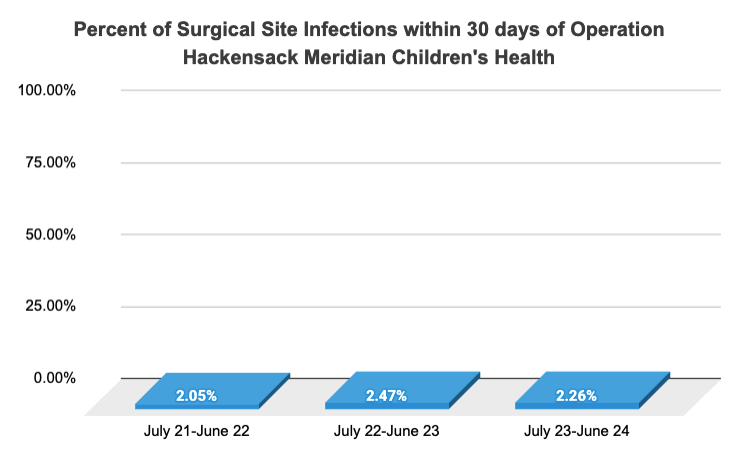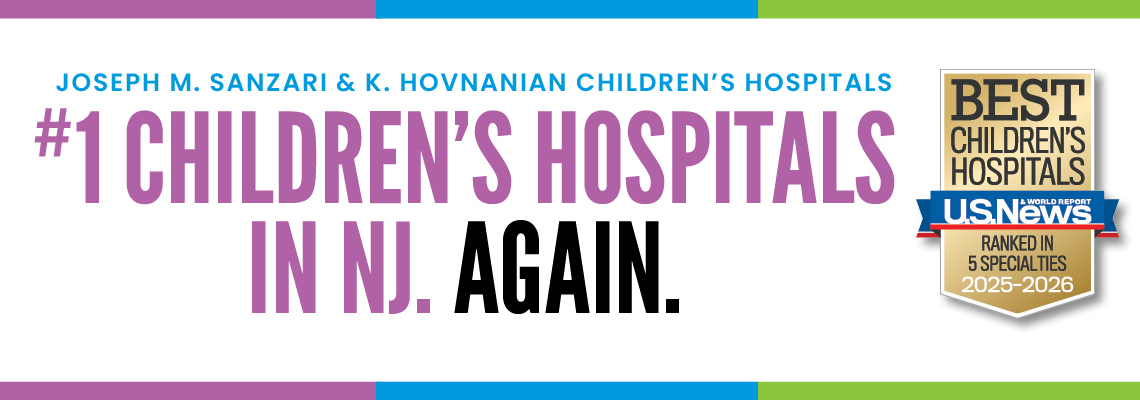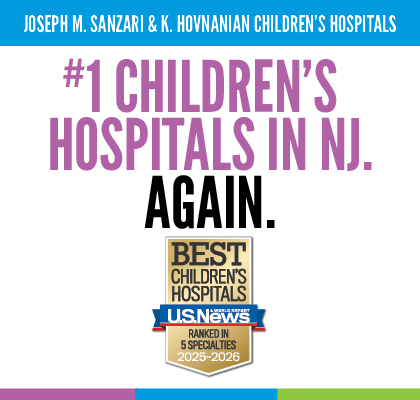Children's Health Quality Reporting
At Hackensack Meridian Children’s Health, our passion is to ensure a safe and high-quality environment for all. We are on our journey to become a high reliability organization.
A high reliability organization delivers excellence in quality and safety always. Our journey includes process improvement, team member training, and partnering with patients and their families to shape our future behaviors and culture. To understand how our efforts are working, we closely monitor outcomes of the care we provide. The links below share some of the quality and safety work being done at Hackensack Meridian Children’s Health.
Central Line-Associated Bloodstream Infections (CLABSI)
- A central line (also known as a central venous catheter) is a catheter or tube that doctors may place in a large vein to deliver necessary treatment. Central lines can remain in place for a long time. They are commonly used in intensive care units and in children with conditions that need prolonged treatment.
- A Central Line-Associated Bloodstream Infection (CLABSI) happens when germs (usually bacteria) enter the bloodstream through a central line. This can result in a serious infection.
- By following strict protocols every time the central line is used, Hackensack Meridian Children’s Health works very hard to prevent infection.
- Hackensack Meridian Children’s Health follows the standards set by the National Healthcare Safety Network to measure CLABSIs.
- The CLABSI rate is the number of infections per 1,000 central line days. Every day a child has a central line in place counts as one central line day.
- We strictly follow high reliability practices in our continuous effort to prevent CLABSIs.
- We focus on best practices and follow standardized protocols which have been proven to lower infection risk.
- We communicate effectively by auditing our practices, regularly reviewing data, and sharing data with patients, team members, and other hospitals.
- We speak up for safety, thoroughly reviewing each CLABSI event to identify improvement opportunities.
- We partner with colleagues and families, by actively participating in Solutions for Patient Safety, a national improvement collaborative aimed at eliminating all patient harm.
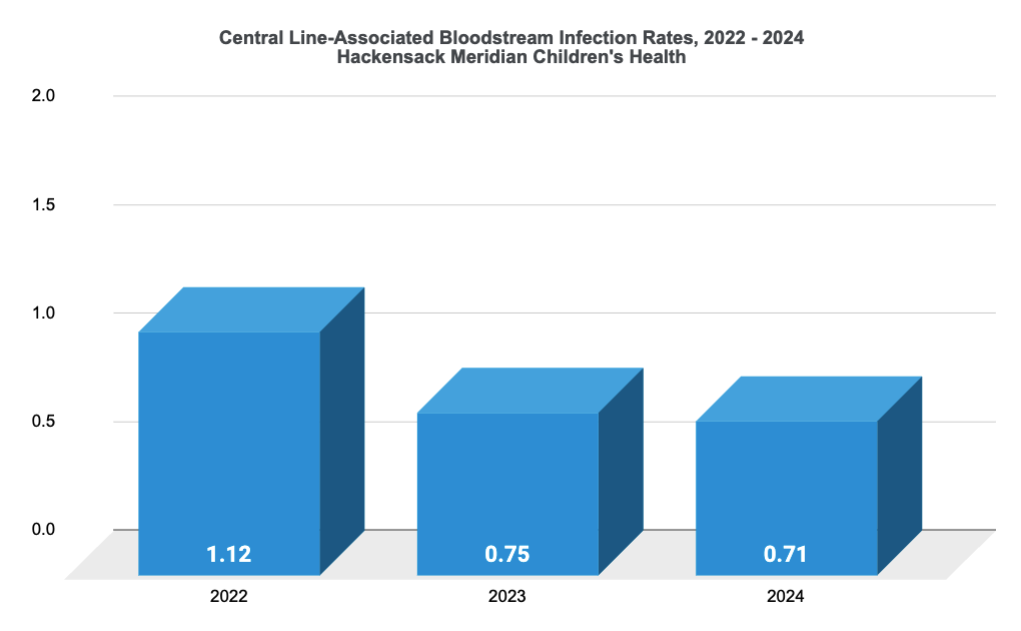
Rates are the number of CLABSIs per 1,000 central line days for each year
*Includes children treated at Joseph M. Sanzari Children's Hospital and K. Hovnanian Children's Hospital
*Lower rates are better
Unplanned Extubation (UE)
- When children are sick, sometimes they need a breathing tube (called an endotracheal tube) and a special machine (called a ventilator) to help them breathe.
- An unplanned extubation (UE) happens when the endotracheal tube is removed or displaced unintentionally.
- Sometimes, this is because the child accidentally pulls the tube out or the tube is moved when the child is being cared for.
- We want to prevent UEs to keep our patients comfortable and safe.
- The UE rate is the number of UEs per 100 ventilator days. Every day a child needs a ventilator counts as one ventilator day.
- We strictly follow high reliability practices in our continuous effort to prevent UEs. We focus on best practices and follow standardized protocols which have been shown to lower UE risk.
- We communicate effectively by auditing our practices, regularly reviewing data, and sharing data with patients, team members, and other hospitals.
- We speak up for safety, thoroughly reviewing each UE event to identify improvement opportunities.
- We partner with colleagues and families, working together to take extra care when children need to be moved or cared for, and actively participate in Solutions for Patient Safety, a national improvement collaborative aimed at eliminating all patient harm.

Rates are the number of UEs per 100 ventilator days for each year.
*Includes children treated at Joseph M. Sanzari Children's Hospital and K. Hovnanian Children's Hospital
*Lower rates are better
Reducing Albuterol in Bronchiolitis
- Bronchiolitis is a lung infection caused by a virus. It can lead to fever, mucus, cough, and difficulty breathing.
- Bronchiolitis is one of the most common reasons young children need to be in the hospital.
- Wheezing frequently occurs in children with bronchiolitis. In the past, children were often treated with albuterol - a medication to improve wheezing.
- However, many research studies have shown that albuterol is not an effective treatment in bronchiolitis. In fact, the American Academy of Pediatrics recommends against giving albuterol in bronchiolitis to avoid side effects and reduce unnecessary treatment.
- The rate of albuterol use is the number of children admitted to the hospital with bronchiolitis who receive albuterol divided by the number of children admitted to the hospital with bronchiolitis. The metric is reported as a percent.
- Hackensack Meridian Children’s Health has a multidisciplinary group dedicated to ensuring our patients receive high quality and safe care.
- We trained our team members, followed evidence-based care protocols, and optimized our electronic health record.
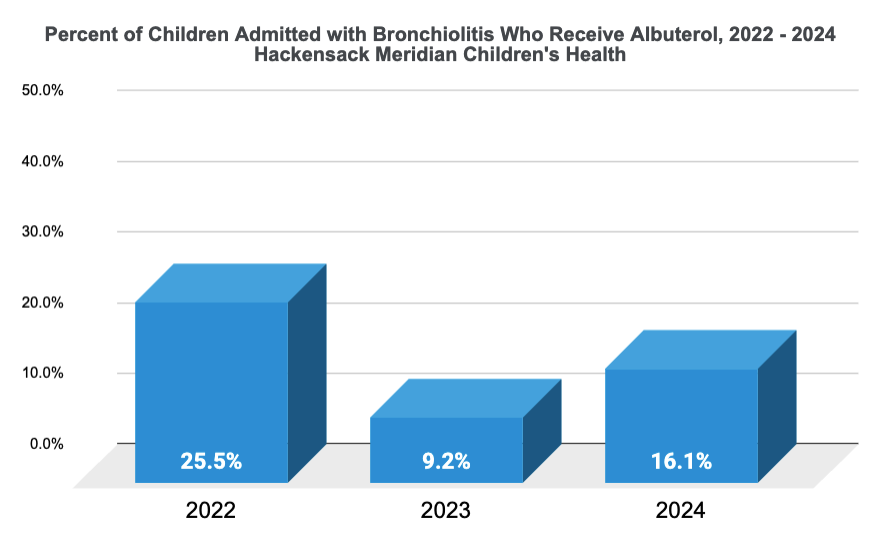
*Includes children treated at Joseph M. Sanzari Children's Hospital and K. Hovnanian Children's Hospital
*Lower rates are better
Hand Hygiene
- Hackensack Meridian Children’s Health understands that hand hygiene is the single most effective way to prevent the spread of infections.
- Preventing the spread of infections keeps children, their families, and our team members safe.
- To ensure good hand hygiene, alcohol-based hand sanitizer or soap and water must be used correctly and for the right amount of time.
- The Centers for Disease Control and Prevention provides guidelines for when and how to perform hand hygiene in the hospital.
- We use two different methods to monitor hand hygiene practice: direct observation and an electronic monitoring system.
- Hackensack Meridian Children's Health maintains the highest standards of hand hygiene practice by committing to:
- Mandatory education and training
- Easy access to sanitizing hand gel dispensers and hand washing sinks
- Real time coaching of missed opportunities
- Continuous evaluation for performance improvement
- Data from monitoring is used to provide individualized feedback and identify targeted interventions
- We encourage all team members, patients, and their families to speak up when they see a missed hand hygiene opportunity to maintain a culture of hand hygiene excellence.
- Hand hygiene compliance shows the percent of time that healthcare workers wash their hands according to guidelines.
- The higher the percent, the better our performance.
- This reflects data from direct observations only

Surgical Site Infections
- A surgical site infection is an infection that happens in the area where a surgeon made a cut during an operation.
- Surgical site infections are a potential risk of any surgery.
- Our skin acts as a protective barrier against harmful germs. Any incision, even if it is necessary, creates a potential entry point for germs to enter the body.
- At Hackensack Meridian Children’s Health, preventing SSIs is a priority and we take every precaution to minimize SSI risk.
- The percent of surgical cases where a patient developed an infection at the site of surgery within 30 days of the procedure.
- We adhere to the highest standards of hygiene and surgical practices to ensure a safe and healthy recovery for children in our care.
- Precautions are taken before, during, and after surgery to appropriately manage an individual’s risk factors, ensure the highest infection prevention standards are met, and adequately prepare families for care at home.
- Families can help prevent SSIs by practicing good hand hygiene, excellent wound care, and close monitoring for signs of infection.
- The Centers for Disease Control and Prevention provides more helpful information.
- The percent of infections at the site of surgery within 30 days after the operation.
- The lower the percent, the better our performance.
- Our rates are as expected for a hospital that performs similar cases.
